There were 8 million unauthorized immigrants in the U.S. working or looking for work in 2014, making up 5% of the civilian labor force, according to new Pew Research Center estimates using government data. The number was unchanged and the share was down slightly since 2009, the year the Great Recession officially ended.1
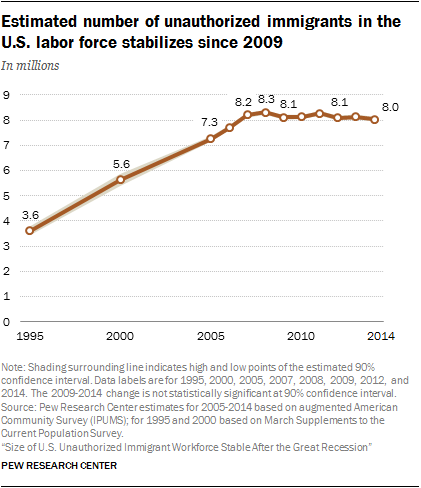
The recent stability in the trend for unauthorized immigrants in the U.S. workforce echoes that for the unauthorized immigrant population overall. Both groups had grown rapidly during the 1990s and early 2000s. Compared with their sizes at the start of the recession in 2007, the unauthorized immigrant workforce was slightly smaller in 2014 and the overall unauthorized immigrant population was markedly smaller. From 2009 to 2014, when the number of unauthorized immigrant workers was stable, eight U.S. states – Alabama, California, Georgia, Illinois, Kansas, Nevada, South Carolina and Rhode Island – had statistically significant declines in the number of unauthorized immigrants in their workforces. Seven U.S. states – Louisiana, Minnesota, New Jersey, Pennsylvania, Utah, Virginia and Washington – had increases in the number of unauthorized immigrants in their workforces.2
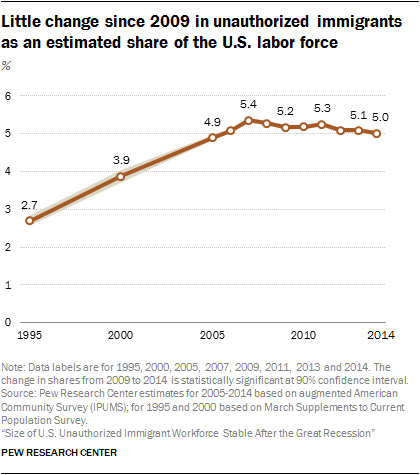
Most states that experienced change in their unauthorized immigrant workforces also experienced change in their total unauthorized immigrant populations. In 12 states, both the total number of unauthorized immigrants and the number of unauthorized immigrants in the civilian labor force changed in the same direction from 2009 to 2014. In three states where the unauthorized immigrant workforce changed from 2009 to 2014 – Minnesota, Rhode Island and Utah – unauthorized immigrant populations overall did not change during the period.
Looking at 2014 estimates, states with the largest number of total unauthorized immigrants in their workforces also were among those states with the largest overall populations of unauthorized immigrants. They included California, with 1.7 million unauthorized immigrant workers; Texas, with 1.1 million; and New York, with 600,000. States where unauthorized immigrants accounted for the largest share of the workforce included Nevada (10.4%); California (9.0%) and Texas (8.5%). (See the chart here for the top states.)
These key findings – and others about the occupations and industries in which unauthorized immigrants work – come from new Pew Research Center estimates based mainly on U.S. Census Bureau data. Details concerning the source material and methods for calculating the estimates are available in the Methodology.
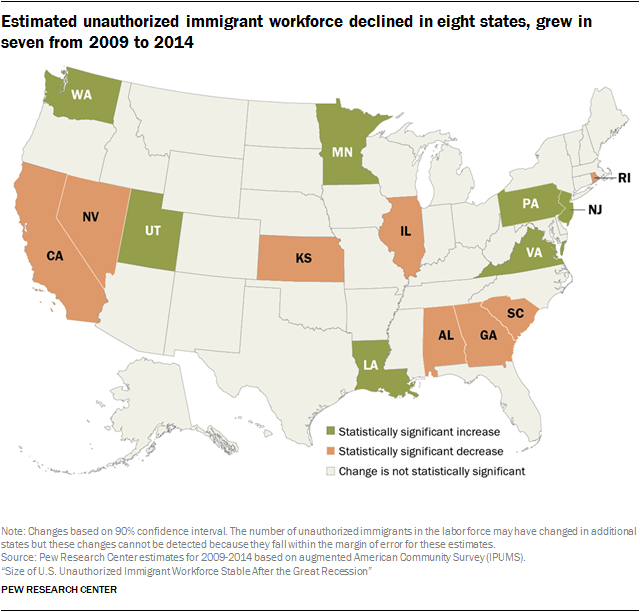
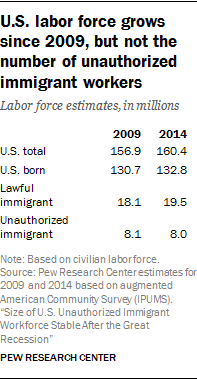
The nation’s 11.1 million unauthorized immigrants made up 26% of the nation’s 43.6 million foreign-born residents in 2014. The U.S. foreign-born population also included 19 million naturalized citizens, 11.7 million lawful permanent residents and 1.7 million lawful residents with temporary status (such as students, diplomats and “guest workers” in the technology sector). In total, immigrants represented 13.6% of the U.S. population in 2014.
In 2014, the nation’s civilian labor force consisted of about 133 million U.S.-born workers (83% of the total), 19.5 million lawful immigrant workers (12%) and 8 million unauthorized immigrant workers (5%). The numbers of U.S.-born members of the workforce and lawful immigrant members of the workforce increased from 2009 to 2014, while the number of unauthorized immigrant workers did not.
Unauthorized immigrants more likely to be of working age than other groups
Unauthorized immigrants make up a larger share of the U.S. labor force (5% in 2014) than of the total population (3.5%) in part because they are disproportionately likely to be of working age. Fully 92% of unauthorized immigrants are ages 18 to 64, compared with 60% of the U.S.-born population and 76% of lawful immigrants.
Among unauthorized immigrants, males are more likely than their U.S.-born and lawful immigrant counterparts to be working or looking for work, while female unauthorized immigrants are less likely to be in the labor force. Fully 91% of unauthorized immigrant men ages 18 to 64 were working or looking for work in 2014, compared with 79% of U.S.-born men of similar age and 84% of lawful immigrants of similar age.
Among women ages 18 to 64, labor force participation was 61% for unauthorized immigrants in 2014, 72% for the U.S. born and 67% for lawful immigrants. One reason for the disparity could be that unauthorized immigrant women who are not in the workforce are far more likely than other groups to have children younger than 18 at home.
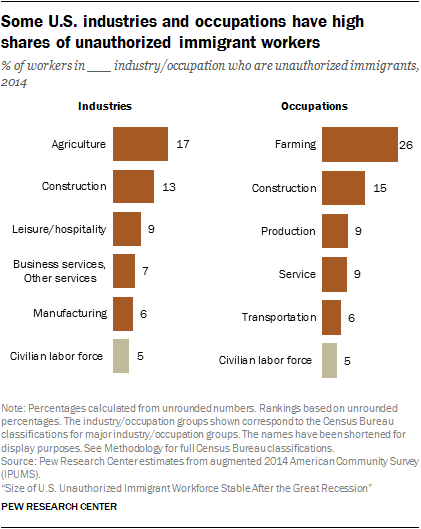
Although unauthorized immigrants work throughout the U.S. economy, they are particularly concentrated in some sectors, according to the Pew Research Center analysis. Compared with their 5% share of the civilian workforce, they were overrepresented in the agriculture (17%) and construction (13%) sectors, as well as in the leisure and hospitality industry (9%). They were underrepresented in some sectors such as the educational and health services sector and the financial and information industries.
By occupation, unauthorized immigrants held a higher share of U.S. farming jobs (26%) in 2014 than would be expected given their share of the workforce. They also held a disproportionate share of construction jobs (15%). By contrast, unauthorized immigrants held a lower share of maintenance, management, professional, sales and office support jobs than their share of the workforce overall.
However, there is no sector or occupation where unauthorized immigrant workers were a majority; in all industries or occupations, they were outnumbered by U.S.-born workers.
Occupation and industry: What’s the difference?
This report on the unauthorized immigrant workforce includes estimates about occupation, which is the kind of work that people do on the job, as well as about industry, which is the kind of business conducted by an employing organization.
Some occupation groups are similar to industry categories – for example, many construction workers are employed in the construction industry. The construction industry, however, also employs people in many other occupations, such as manager, clerk, etc.
The Census Bureau obtains data on occupation and industry from responses to write-in and check-box questions; the responses are coded using a standard classification system.
The unauthorized immigrant estimates in this report are produced using a multistage method that first subtracts the estimated U.S. lawful foreign-born population from the total adjusted foreign-born population to derive a residual estimate of the unauthorized immigrant population. Then, the residual estimates serve as control totals in assigning legal status to individual respondents in the survey. The main source of data for 2005-2014 is the American Community Survey, conducted by the U.S. Census Bureau; see Methodology for more details.
Accompanying this report are interactive maps showing 2014 estimates for the 50 states and District of Columbia on:
- The unauthorized immigrant population
- Unauthorized immigrants’ share of each state’s overall population, foreign-born population and labor force
- The share of K-12 students with unauthorized immigrant parents
- Mexicans as a share of unauthorized immigrants
- Statistically significant change in the unauthorized immigrant population from 2009 to 2014
Another interactive graphic shows unauthorized immigrant population trends for U.S. states of residence as well as international regions and largest countries of birth, based on a previous Pew Research Center report.
Some unauthorized immigrants have permission to work
Unauthorized immigrants include those who enter the country without legal permission and those who overstay their visas. About 10% of unauthorized immigrants have been granted temporary protection from deportation – and eligibility to work – under two government programs. They include more than 728,000 young adults who were brought to the U.S. as children and successfully applied for President Barack Obama’s 2012 Deferred Action for Childhood Arrivals program. The program rules state that unauthorized immigrants must have been be no older than 30 as of June 15, 2012; must have been brought to the U.S. before age 16; and must have lived in the U.S. continuously since June 15, 2007. In addition, eligible applicants have to be in school, hold a high school diploma or General Education Development (GED) certificate, or be an honorably discharged military veteran. The rules also specified that they cannot have a significant criminal record and cannot “pose a threat to national security or public safety.”
Those seeking eligibility had to submit documents to prove their claim and pay a $465 filing and biometric fee. They also had to submit fingerprints, a photo and a signature for security purposes. An additional 4 million young adults and their parents would have been eligible under an expansion that has been blocked by a federal court.
Under the second program, an estimated 326,000 immigrants, mostly from Central America, have been granted Temporary Protected Status because of disease, natural disaster or conflict in their home countries. The Pew Research Center estimates of the unauthorized immigrant population also include some people who have applied for asylum status but whose applications have not been processed. As of April 2014, about 45,000 cases of principal applicants were pending; if family members are included, that total might rise to as much as 75,000.
“Foreign born” refers to an individual who is not a U.S. citizen at birth or who, in other words, is born outside the U.S., Puerto Rico or other U.S. territories and whose parents are not U.S. citizens. The terms “foreign born” and “immigrant” are used interchangeably.
“U.S. born” refers to an individual who is a U.S. citizen at birth, including people born in the United States, Puerto Rico or other U.S. territories, as well as those born elsewhere to at least one parent who is a U.S. citizen.
The “lawful immigrant” population is defined as naturalized citizens; people granted lawful permanent residence (previously known as legal permanent residence); those granted asylum; people admitted as refugees; and people admitted under a set of specific authorized temporary statuses for longer-term residence and work.
“Unauthorized immigrants” are all foreign-born noncitizens residing in the country who are not “lawful immigrants.” These definitions reflect standard and customary usage by the U.S. Department of Homeland Security and academic researchers. The vast majority of unauthorized immigrants entered the country without valid documents or arrived with valid visas but stayed past their visa expiration date or otherwise violated the terms of their admission. Some who entered as unauthorized immigrants or violated terms of admission have obtained work authorization by applying for adjustment to lawful permanent status, obtaining Temporary Protected Status (TPS) or receiving Deferred Action for Childhood Arrivals (DACA) status. This “quasi-lawful” group could account for as much as 10% of the unauthorized immigrant population. Many could also revert to unauthorized status.
The “labor force” refers to the civilian labor force, unless otherwise specified, including people ages 16 and older who are employed, or unemployed and looking for work. “Workforce” is used interchangeably with labor force. People in the labor force are referred to as “workers” regardless of their employment status. Similarly, when there is analysis of estimates for occupations, “occupation” and “job” are used interchangeably. And for industries, “industry” and “sector” are used interchangeably.
The occupation and industry category titles used throughout the report have been shortened for display purposes. The full list is included in the Methodology.




